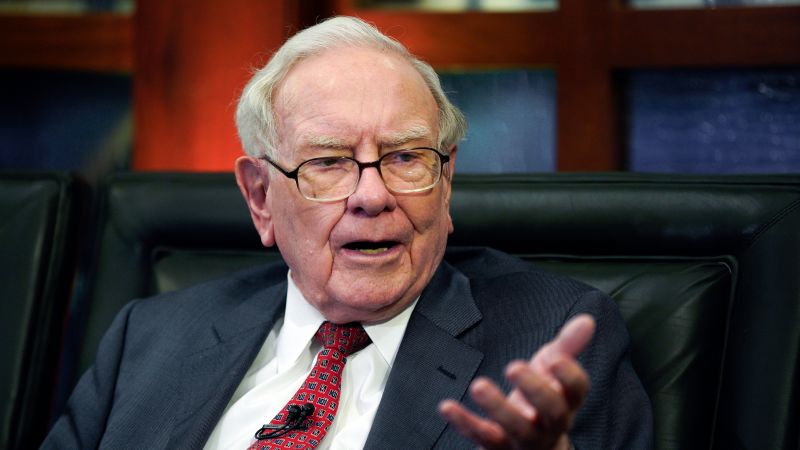A version of this story first appeared in CNN Business’ Before the Bell newsletter. Not a subscriber? You can sign up right here. You can listen to an audio version of the newsletter by clicking the same link.
The “Buffett Indicator” is flashing red.
In 2001, Warren Buffett came up with what he called in Fortune Magazine “probably the best single measure of where [stock] valuations stand at any given moment.”
Today that barometer has soared to a two-year high, signaling that a market retreat could be coming.
What’s happening: Widely known as the “Buffett Indicator,” it measures the size of the US stock market against the size of the economy by taking the total value of all publicly traded companies (measured using the Wilshire 5000 index) and dividing that by the last quarterly estimate for gross domestic product.
The resulting ratio is supposed to tell us how fairly priced stocks are by providing a simple gauge of whether the market is overvalued or undervalued relative to economic output. If the stock market is growing a lot faster than the economy, that could be a sign of a bubble.
Buffett’s Berkshire Hathaway says that a reading of 100% is fair, if it’s closer to 70% stocks are at a bargain price, and if it’s anywhere near the 200% mark, investors are “playing with fire.”
The indicator is currently sitting near a two-year high, at nearly 190%.
The last time the indicator was this high was in 2022, when it hit 211% and the S&P 500 dropped by 19% over the next year.
Bubble territory: Markets have surged higher this year as investor enthusiasm over artificial intelligence stocks have sent chipmakers like Nvidia to all-time highs.
Wall Street is also betting that there will be three interest rate cuts by the Federal Reserve this year, and investors have been preemptively celebrating.
But some analysts are ringing the alarm. They’re worried that AI fervor is misguided. Plus, two Fed officials have forecast no interest rate cuts at all this year.
“My impression is that investors are presently enjoying the double-top of the most extreme speculative bubble in US financial history,” legendary investor John Hussman wrote in a recent note. Hussman predicted the 2000 and 2008 market crashes.
Former Treasury Secretary Larry Summers also fretted over markets last week. “I certainly think we’re at least at the foothills of bubbles,” he said on Bloomberg.
Louis Navellier of Navellier & Associates thinks US markets are in a melt-up that’s being widely ignored by investors. “The market continues to march relentlessly higher and no one is willing to call a top,” he said in a note.
The S&P 500 has surged more than 10% since January, and last week it surpassed Goldman Sachs’ year-end target of 5,200. Analysts at the bank now say there’s a scenario where it could rise an additional 15% to 6,000 by the end of the year.
“As always, there are a lot fewer questions about why the market is up than there are when it trades down,” said Navellier.
Yes, but: The so-called Buffett Indicator is not without flaw. It ignores how much money companies make abroad and doesn’t consider how interest rates might change a company’s valuation. Buffett himself has conceded that the very simple metric has its limitations.
And while markets are frothy, they’re not exactly bubbling.
“This is not hype,” JPMorgan Chase CEO Jamie Dimon told CNBC last month about a potential AI bubble. “When we had the internet bubble the first time around… that was hype. This is not hype. It’s real,” he said. “People are deploying [AI] at different speeds, but it will handle a tremendous amount of stuff.”
The froth appears to be settling — about 23% of S&P 500 companies made a new 52-week high last week, and the equal-weighted S&P 500 is up by nearly 25% since its October 2023 low. That makes this market more “believa-bull,” quipped Kevin Gordon, senior investment strategist at Charles Schwab.
But, he told CNN, “we continue to think the market is vulnerable to a looming negative catalyst — particularly on the earnings front — given both attitudinal and behavioral sentiment metrics are in extreme optimism territory.”
The last trading day of the quarter falls on Thursday, and earnings reports begin in early April.
Visa and Mastercard agree to $30 billion settlement that will lower merchant fees
Two of the world’s largest credit card networks, Visa and Mastercard, as well as the banks that issue cards with them, have agreed to settle a decades-long antitrust case brought upon by merchants, reports my colleague Elisabeth Buchwald.
The settlement is set to lower swipe fees merchants pay when customers make purchases using their Visa or Mastercard by $30 billion over five years, according to a press release announcing the settlement Tuesday morning.
The settlement, which only applies to US merchants, is the result of a lawsuit filed in 2005. However, nothing is considered finalized until it receives approval from the US District Court for the Eastern District of New York. Even then, the case can also be appealed in what could be a lengthy battle.
Typically, swipe fees cost merchants 2% of the total transaction a customer makes — but can be as much as 4% for some premium rewards cards, according to the National Retail Federation. The settlement would lower those fees by at least 0.04 percentage point for a minimum of three years.
For the first time in almost 30 years, part of Donald Trump’s business empire has gone public. Trading started with a bang, but the frenzy eased considerably by the closing bell, with shares ending well off their highs of the day, reports CNN’s Matt Egan.
Trump Media & Technology Group, the owner of struggling social media platform Truth Social, began its long-delayed journey as a public company at Tuesday’s opening bell under the ticker symbol “DJT.”
The stock surged about 56% at the open, to $78, and trading was briefly halted for volatility. Trump Media shares stabilized around $70 before fizzling. By the closing bell, Trump Media ended at $57.99, up by a more modest 16% on the day.
The skyrocketing share price comes despite the fact that Trump Media is burning through cash; piling up losses; and its main product, Truth Social, is losing users.
“This is a very unusual situation. The stock is pretty much divorced from fundamentals,” said Jay Ritter, a finance professor at the University of Florida’s Warrington College of Business, who has been studying initial public offerings (IPOs) for over 40 years.
Ritter said the closest parallel would be GameStop, AMC and other so-called meme stocks that skyrocketed during Covid-19 as an army of retail traders piled in. He said Trump Media is likely worth somewhere around $2 a share — nowhere near its closing stock price of $58.
Read the full article here




